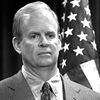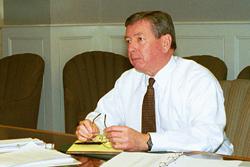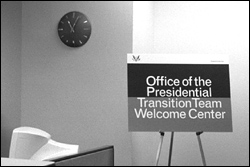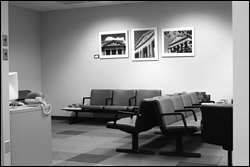 Vice president elect Dick Cheney chairs the transition. |
 Clay Johnson, III |
Because the election outcome remained "unclear and un-apparent" due to the battle for Florida's 25 electoral votes, official transition activities were put on hold for over a month. Not until December 15, 2000 did Thurman Davis, the Deputy Administrator of the General Services Administration, hand Vice President Elect Dick Cheney the electronic key card to the official transition offices. The handover represented access to ninety thousand square feet of office space in a building just a couple of blocks from the White House, and $5.3 million in federal funds for the transition effort.
However, the Bush team had not been resting during the thirty six days of uncertainty. Gov. Bush formally began his transition on November 26, 2000, the day Florida Secretary of State Katherine Harris certified him as the winner of the state's 25 electoral votes. He named running mate Dick Cheney to head the transition and established a Texas nonprofit corporation, the 2000 Bush-Cheney Presidential Transition Foundation, Inc., to raise private funds to support the transition. Some personnel were announced, offices opened in McLean, Virginia, and a website was launched complete with job application forms.
By mid-December about a hundred staff and volunteers were working out of the McLean offices. The transition had raised $3 million in private funds. Thousands of resumes had been processed. Transition press secretary Ari Fleischer said the Bush team used the period of electoral limbo to "quietly and privately get a lot of work done."
Nonetheless, Vice President Gore's challenge did put a crimp in the transition. The McLean office did not open until November 30. Due to the challenge situation it was impossible for Bush's people to interface with personnel in the various departments. For a time there were actuually two transitions in progress. Vice President Gore, whose path to the presidency appeared more problematic than Bush's, initiated his own transition under the direction of Roy Neel, a close, long-time aide on leave from his position as president of the U.S. Telephone Association.
With the election finally decided in
Bush's favor, the task of assembling the new
administration came into full focus.
Speculation on various prospects was the order of
the day; in addition to the different names bandied
about, observers wondered whether President-Elect
Bush would be able to find a willing Democrat.
By Christmas, Bush had announced about half of his
Cabinet, and on January 2 he named his final three
picks for Cabinet secretaries. However, on
January 9 Labor Secretary-designate Linda Chavez
withdrew from consideration due to a controversy
over her help for an illegal immigrant; Bush named
Elaine Chao as his new choice for the position on
January 11. The fourteen Secretary-designees
thus include three women, two blacks, one Hispanic,
two Asian-Americans, two sitting governors, two
recently defeated U.S. Senators, and, yes, one
Democrat.
| ...he shall nominate, and by and
with the advice and
consent of the Senate, shall appoint
ambassadors, other public ministers and
consuls, judges of the Supreme Court, and all
other officers of the United States, whose
appointments are not herein otherwise provided
for, and which shall be established by law...
Article II, Section 2
|
 |
Jan. 15, 2001--John Ashcroft prepared for his confirmation hearings, which began in the Senate Judiciary Committee the next day. The Ashcroft nomination drew sharp criticism from a host of liberal groups, while conservatives rallied to back the Missourian (for | against). Time ("Should This Man Be Attorney General?") and Newsweek ("Holy War") both featured Ashcroft on this week's cover. |
| Cabinet secretaries are only the tip of the iceberg when it comes to presidential appointments. Myriad sub-Cabinet posts must be filled, including deputy secretaries and agency heads. The White House staff is also taking shape. There is no shortage of aspirants for positions in the Bush-Cheney administration; by January 2, 2001 the transition office had received 42,041 resumes. |
 The Plum Book |
Links
180





